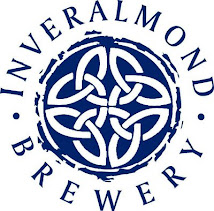 Here is some Pale Ale Malt which is the base for all our ales. Malt is barley that has been germinated (or grown) for a few days to allow enzymes in the grain to turn the hard concrete-like starch into a crumbly soft form easily dissolved into water. Then the malt is dried and cured or kilned in a huge oven. The drying and kilning processes take many forms which give us many different kinds of malt. Pale Ale Malt is the one which is merely dried then very lightly kilned. Pale Ale Malt will account for at least 85% of the grist (or the grain bill) of any of our ales. Other malts can be Caramel, Crystal, Dark Crystal or Chocolate Malts to name but a few of those that we use. Below there's a shot of 4 kinds of malt that we use every week.
Here is some Pale Ale Malt which is the base for all our ales. Malt is barley that has been germinated (or grown) for a few days to allow enzymes in the grain to turn the hard concrete-like starch into a crumbly soft form easily dissolved into water. Then the malt is dried and cured or kilned in a huge oven. The drying and kilning processes take many forms which give us many different kinds of malt. Pale Ale Malt is the one which is merely dried then very lightly kilned. Pale Ale Malt will account for at least 85% of the grist (or the grain bill) of any of our ales. Other malts can be Caramel, Crystal, Dark Crystal or Chocolate Malts to name but a few of those that we use. Below there's a shot of 4 kinds of malt that we use every week.  From L to R we have Pale Ale, Caramel, Dark Crystal and Chocolate Malt. You can see that the colours are getting darker with each type. Caramel and the Crystal Malts are caramelised, by stewing the wet grain at 65C so that the enzymes in the malt go one stage further by turning the starch into sugars, then the heat is raised and the moisture is allowed to evaporate so that the sugars inside the grain crystallise (hence crystal in the name) and caramelise giving rich luscious toffee flavours. The more the malt is caramelised, the darker the colour. The Chocolate Malt (named for its resemblance, not taste, to the bean!) on the right is very dark and roasted much like a coffee bean, more like espresso coffee and even has the aroma of coffee. In brewing terms all the malts have a colour number - Pale Ale is around 4 - 6, Caramel Malt 25 -35, Crystal 125 -150, Dark Crystal 400 and Chocolate about 1100.
From L to R we have Pale Ale, Caramel, Dark Crystal and Chocolate Malt. You can see that the colours are getting darker with each type. Caramel and the Crystal Malts are caramelised, by stewing the wet grain at 65C so that the enzymes in the malt go one stage further by turning the starch into sugars, then the heat is raised and the moisture is allowed to evaporate so that the sugars inside the grain crystallise (hence crystal in the name) and caramelise giving rich luscious toffee flavours. The more the malt is caramelised, the darker the colour. The Chocolate Malt (named for its resemblance, not taste, to the bean!) on the right is very dark and roasted much like a coffee bean, more like espresso coffee and even has the aroma of coffee. In brewing terms all the malts have a colour number - Pale Ale is around 4 - 6, Caramel Malt 25 -35, Crystal 125 -150, Dark Crystal 400 and Chocolate about 1100. Beer gets its malty characters and colour from the malt types used in the mash tun. As I said before, Pale Ale Malt or Pale Malt as we tend to call it, makes up the majority of a brew, but we'll add some of the darker malts depending on the flavour we want. Ossian, a golden ale, has less than 4% of its grist as the very lightly coloured Caramel Malt, whereas Lia Fail, quite a dark, strong and more robust flavoured brew, has just less than 2% of the Dark Crystal and just over 1% of the Chocolate Malt. The darker the malt, the less is needed to make a substantial difference to the colour and flavour. A normal stout, which you cannot see through in a pint glass, for example, usually has no more than 8% of the highly roasted Chocolate Malt to give it that coffee-like, almost burnt-biscuity character with the rest of the grist being Pale Malt.
If, however, we only use a small proportion, about 2% say, of highly-coloured malt, such as Dark Crystal, we can get a coppery, amber hue with just enough of the luscious caramel richness of that special malt as in Santa's Swallie, which we brewed for export to the USA and Scandinavia last month.
 Merry Christmas, when it comes and may it be malty!
Merry Christmas, when it comes and may it be malty!Slàinte, Ken



